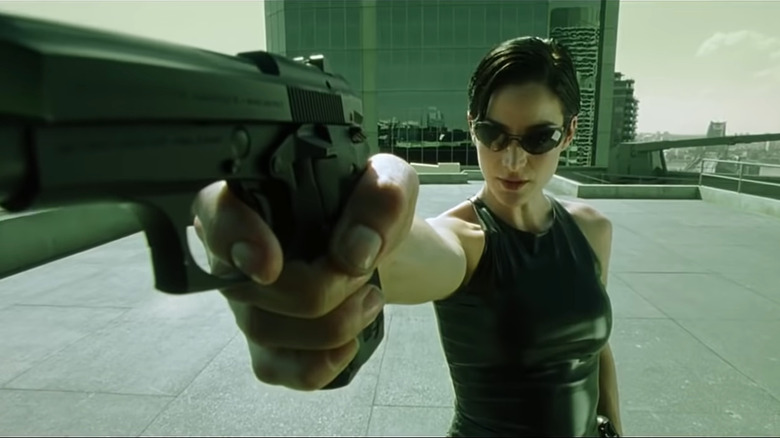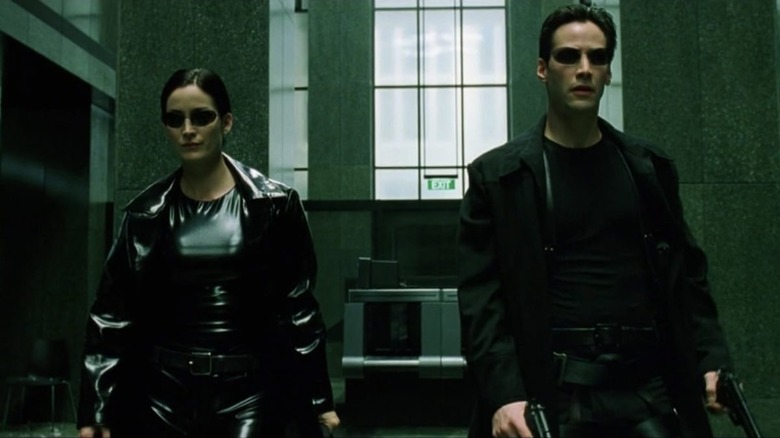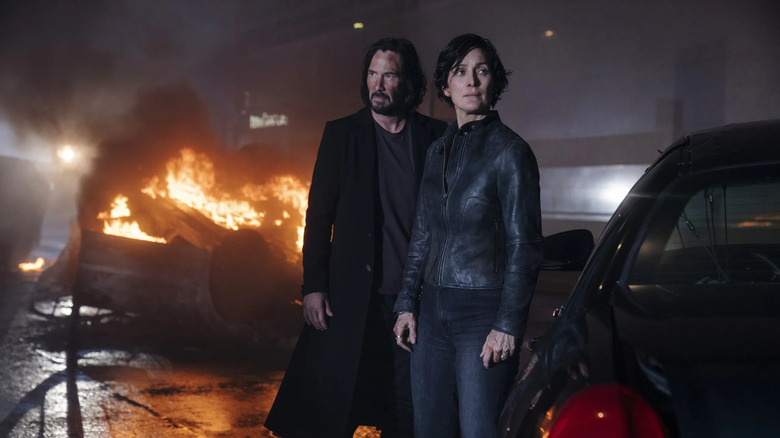Carrie-Anne Moss' Matrix Audition Truly Tested Her Physical Limits
There's a lot to love about the first "Matrix" movie, from the groundbreaking action to all the surprisingly deep philosophical questions the film raises. Perhaps a slightly underrated aspect, however, is Carrie-Ann Moss's performance as Trinity. Although "Resurrections" was likely the franchise's best showcase for Moss's acting chops, Moss's Trinity is a vital part of the first film. She serves as the warm, human presence contrasting with the cold, corporate world of the Matrix. The way she reassures Neo in the beginning and pushes him to continue searching for answers is a big part of why Neo eventually takes the red pill.
Moss's performance also helps to sell the ending to "The Matrix," in which a seemingly dead Neo is brought back to life by Trinity confessing her love for him and giving him a kiss. The franchise positions Neo and Trinity as soulmates whose love for each other is so powerful it can break the laws of physics. The script itself doesn't actually do much to establish this dynamic, especially in the first movie, so it's Moss's acting that does a ton of the heavy-lifting to make it work.
Moss almost didn't get the part, however. Much like how the part of Neo was almost performed by Will Smith, the part of Trinity was nearly played by Jada Pinkett Smith, who would end up playing the character of Niobi in the sequels. "Keanu and I didn't click," Smith said about her audition process. "We just didn't have any chemistry." In the end, they went with Moss for Trinity, and because Trinity was involved in a ton of action scenes, this meant there was a lot of physical training in store for Moss in the months ahead.
A physically demanding role
The Wachowskis wanted the actors to be able to perform most of their own stunts so that they wouldn't have to rely on camera cuts to switch to the stunt doubles like in a typical action movie. This attitude resulted in some of the most impressive, innovative action scenes of the time, but it meant a lot of extra work on behalf of the actors themselves. The famous shootout in the lobby scene involved both Neo and Trinity doing constant flips and kicks, which involved months of physical training beforehand. Regarding a specific cartwheel Trinity had to do off a wall, Moss told WIRED, "The weekend before I had to do it, I was in the training center in tears, saying: 'I can't do it! I can't do it!'" She ended up injuring her ankle during training, but still managed to pull the scene off when the time came.
It was scenes like this that explained why Moss's screen test was several days long and included constant practice with stunt performers. "I couldn't walk for days," she said, regarding the days following the screen test. "I remember thinking, 'They don't really think I'm gonna do this stuff, like jumping from one building to another. Of course I'm not going to do that!'" Turns out, they mostly did. In addition to the months of training prior to filming, the sequels would include some of the most dangerous stunt work of Moss's career. The highway chase sequence in "Reloaded" took about seven weeks to film, and required a lot of helmetless motorcycle driving from Moss, who by her own admission was "not a very experienced motorcycle rider."
Lana Wachowski's change in approach
The hard work seemed to pay off, as the original "Matrix" trilogy was widely lauded for its innovative action scenes, even if the writing itself wasn't always received as positively. Looking back at the grueling training process and expectations for the main actors, however, it's hard not to wonder if the Wachowskis were taking things too far in the name of art. Was a cool action scene really worth putting the actors in these kinds of dangerous situations? The experience was particularly stressful for Moss because it wasn't just her own life at stake:
"A passenger who's life depended on me being impeccable and perfect because I knew that if I allowed my mind one moment of doubt that I could hurt another human being ... I held that for all of those days... It was exhausting holding that mental absolute knowing that I was going to keep him alive."
In a 2021 interview, actor Jonathon Groff explained how Lana Wachowski's directing style changed since she came out as transgender, saying, "She would storyboard things like they were comic books almost, and create exact frames of what she wanted as her way of literally controlling her narrative, because there was so much out of control inside of her." After she came out, Groff said she became more open to "capturing the things that can't be controlled." From the Entertainment Weekly interview: "The cast, he says, never over-rehearsed and Lana herself was never quite explicit in what she wanted from her actors."
The result was a fourth movie in which the action scenes didn't reach the originals' heights, but in which the actors weren't put through nearly as much stress, and given more creative freedom. We'd argue it was worth the trade-off.


